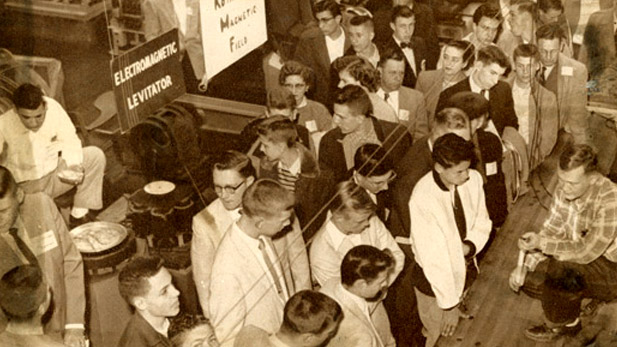Students to Showcase Projects as ‘The Rose Show’ Returns

Rose-Hulman’s version of a World’s Fair, The Rose Show was a biennial event that showcased student ingenuity, creativity and problem solving. It was a popular campus and community occasion, attracting thousands of visitors.
The Rose Show returns Wednesday, May 2, on campus after nearly a 20-year hiatus, as a showcase for ingenuity, creativity and problem solving by students who will be tomorrow’s leaders in science, engineering and mathematics.
More than 80 projects completed this school year by first-year students through seniors in several academic areas, most of them completed for external clients, will be displayed in the Sports and Recreation Center’s Hulbert Arena from 12:30-3:30 p.m. The event is free, and the public is encouraged to attend and learn what’s happening in technology. Representatives from industry will judge student projects and to pitch possible future project ideas.
Rose-Hulman’s version of a World’s Fair, The Rose Show was a biennial event that was a popular campus and community occasion, attracting thousands of visitors. The first show in 1927 was attended by 3,486 people, according to published reports, and the event reached its peak with 6,765 people visiting exhibits in 1932.
The school newspaper, The Technic, described the 1934 show as “one of the most important events in school history,” in part because it required students to plan, organize and execute the event, and answer questions from the public about their presentations.
Vintage project displays featured such technology as X-rays, a cup of coffee made from raw sewage, waste-eating bugs, “Edisonia” historical relics loaned by Thomas Edison, chemistry magic shows, balsa wood miniature bridge busting and a “Love-O-Meter” device.
The Rose Show disappeared in 1940 and—with the exception of a one-day “Little Rose Show” in 1952—would not return until Rose-Hulman’s centennial year of 1974. It continued as a staple of Parent’s Weekend each spring for the next 27 years, ending after 2001.
This year’s projects will feature an unmanned aviation emergency response vehicle, a spring-loaded rod and reel device that allows disabled veterans to cast and enjoy fishing, an aging simulation biomedical engineering device, a device that allows for easy filling and closing of sandbags for agricultural and disaster relief, and a phototherapy device that helps newborn babies experiencing jaundice.
Also, there will be a surgical knot tying training board, a “smart desk” that adjusts desk height for different users and tracks employee space utilization, a wheelchair that easily adjusts to growing children, a multi-pipe waste disposal system to help alleviate infections in hospital sinks, and a custom-made bicycle that allows a young girl with Cerebral Palsy to enjoy rides with family and friends.

